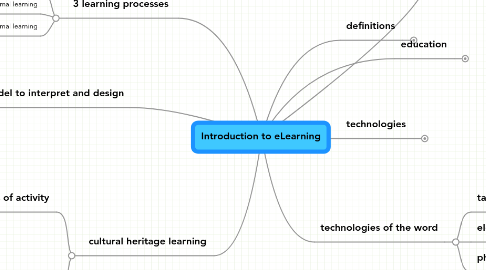
1. 3 learning processes
1.1. formal learning
1.2. non-formal learning
1.3. informal learning
2. cultural heritage learning
2.1. 4 areas of activity
2.1.1. archives
2.1.2. museums
2.1.3. cultural environments
2.1.4. arts
2.2. main characteristics
2.2.1. Active Learners
2.2.2. Learning is an interplay
2.2.3. Learning involving several senses
2.2.4. Learners are emotionally affected
3. a model to interpret and design
3.1. people
3.1.1. support
3.1.2. communication
3.2. methods
3.2.1. space
3.2.2. time
3.3. contents
3.3.1. interactivity
3.3.2. media
4. different approaches to instructional design
4.1. the linear approach
4.2. the heuristic approach
4.3. prototype models
4.4. constructivist approach
5. definitions
5.1. 1. ICTs in education 2. internet in education 3. how education changes due to ICTs and the internet
5.2. the use of new multimedia technologies and the Internet to improve the quality of learning by facilitating access to resources and services as well as remote exchanges and collaboration
6. education
6.1. learning outcomes
6.1.1. Savoir - knowledge Savoir faire - skills Savoir être - attitudes
6.1.2. MLA Generic Learning Outcome
6.1.2.1. Knowledge and Understanding Skills Attitudes and Values Enjoyment, Inspiration, Creativity Activity, Behaviour, Progression
6.2. 3 forms of the activity of educating
6.2.1. Verbalization
6.2.2. Examples
6.2.3. Modeling
6.3. 3 basic elements in education and in the didactic contract
6.3.1. People
6.3.2. Contents / goals
6.3.3. Methods / strategies
6.4. 3 remarks
6.4.1. education is always education of people
6.4.2. the fundamental communicative and educational experience of human beings is the interpersonal dialogue characterized by the presence of the interlocutors and by the sharing of their experience and meanings
6.4.3. education has always tried to make use of technologies (of the word and not) and the available strategies- and has created new ones as well- so that the educational experience is enriched and made more efficient and effective
7. technologies of the word
7.1. taxonomies
7.1.1. 1. which aspects of communication a technology is able to fix.
7.1.2. 2. the activities and processes required for the objectification.
7.1.3. 3. the possiblity to move phisical supports of communication in space
7.1.4. 4. conditions for access and interpretation
7.1.5. others: 1. synchronous / asynchronous; 2. bandwidth
7.2. electronic texts characteristics
7.2.1. 1. directly inaccessible to human senses
7.2.2. 2. immaterial
7.2.3. 3. perfectly reproducible
7.2.4. 4. always accessible without any limit of space
7.2.5. 5. modified as much as one wants
7.2.6. 6. multimedia
7.2.7. 7. persistent
7.2.8. 8. interactive
7.2.9. 9. high degree of customization
7.3. philosophies towards ICTs
7.3.1. determinism
7.3.2. instrumentalism
8. technologies
8.1. web 2.0
8.1.1. features
8.1.1.1. User Generated Contents
8.1.1.2. Public Square
8.1.1.3. Fulfilling Multimedia Promises
8.1.2. tools
8.1.3. used in formal and informal educational contexts
8.2. categories
8.2.1. infrastructure
8.2.2. delivery applications
8.2.2.1. LMS
8.2.2.1.1. contents
8.2.2.1.2. evaluation
8.2.2.1.3. management
8.2.2.1.4. communication
8.2.3. productivity applications
